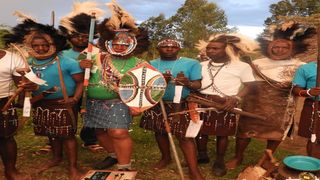
Some of the members of the celebrated Kaplelaach traditional dancers whose base is Kapkimolwo in Bomet county.
| Vitalis Kimutai | Nation Media GroupBomet
Premium
Elders keen to immortalise cultural festivals, artefacts
A group of elders is seated under a huge acacia tree, chatting away in the cool evening breeze.
On the horizon, the setting sun has turned into a golden orb, bathing the whole place in the dazzling colours of the rainbow.
Oblivious of the elders’ business, young boys are engaged in a not-so-organised football match not very far away, kicking back and forth a tattered hand-woven ball in an open but uneven field.
There is neither a referee nor linesmen for the match – and neither side boasts any fans.
The boys are, nevertheless, so engrossed in their match they hardly notice what else is going on around and beyond the pitch.
Having grazed to their fill in the open fields all day long, the cattle are sprawled under a big canopy of trees on the edges of the field, patiently waiting for the boys to end their match and drive them back to their respective homesteads.
Welcome to Kapkimolwo trading centre in Longisa civic ward, Bomet East constituency, the cultural cradle of the Kipsigis community.
In the early to late 1900s, members of the community used to stage wrestling competitions at the centre, which attracted hundreds of fans.
The wrestling festivals drew competitors from far and wide. The elders would preside over the crowning of the wrestling champion, a title that was highly revered.
The dances and wrestling festivals were invariably planned to coincide with open-air market activities.
Wrestling match
“Towards the close of a market day, the traditional dances were staged, followed by a wrestling match,” said Mr Alexander Chumo, a former chief in the area.
Men engage in a mock wrestling at Kapkimolwo trading centre in Bomet county.
“The wrestling festivals hit a crescendo in the 1940s, but after independence they started to fizzle out.”
Mr Chumo explained that despite the elaborate planning that preceded such events, the winners did not get any gift, since winning was considered to be a reward in itself.
These were memorable events and many are said to have identified and started pursuing their future spouses during such ceremonies.
And now elders are keen to revive the competition and document the tradition through collection of traditional artefacts for purposes of preservation of and recording of traditional songs.
The area has been popularised by a traditional song, ‘Kapkimolwo Longisaikere ra lelo’ – sang in praise of Lelo arap Sitonik, a member of the Babasik clan who held the title of wrestling champion for a very long period.
He is said to have later migrated to the neighbouring Chemaner location, where he settled.
Kapkimolwo is home to Kaplelach cultural group dancers, who in 2018 were supposed to participate in a Unesco conference in Paris, France, on November 9, 2018, after winning in the traditional dance category in a competition held earlier in Kisumu.
Kaplelach traditional dancers members with traditional cooking pots.
They dropped out after failing to get sponsorship.
“Apart from songs, we are collecting traditional cultural artefacts and tools used by various generations of the Kipsigis community. We want to preserve them for future generations by developing a museum in the area,” said Mr Philemon Malel, the leader of the dance troupe.
Semi-permanent houses
Old semi-permanent houses, which were used as shops and administration offices, still stand at the centre, many now rendered decrepit by huge cracks and rusty iron roofs. The units are said to have been constructed in the 1930s to late 1940s.
An old cracked building constructed using bricks at Kapkimolwo trading centre that was built in the 1940s.
Members of the Asian community had established business premises in the area but later relocated to other regions.
Elders allege the centre failed to grow into a major trading hub for the Western region due to a curse imposed on it by a fortune teller.
The elders further allege the fortune teller left the area in a huff in the 1950s after being mistreated by the community.
“The fortune teller was from the Talai community in Kericho, but we have traced the family and we are currently performing various traditional rites to cleanse the area. The ‘offended’ family has been traced and is involved in the process,” said Mzee John Kiptangus Birir, an elder.
Kapkimolwo police station, located a few metres from the shopping centre, is one of the oldest security bases in the South Rift region.
It is alleged the fortune teller was also blocked from crossing to the neighbouring Narok South region, which had no human settlement at the time.
It is further claimed the police station was closed down under mysterious circumstances shortly thereafter and was only reopened a few years ago after traditional rites were conducted.
Bomet County Principal Tourism Officer Charles Korir said they had received proposals from residents and leaders to develop a cultural site at the trading centre.
The Tourism Board of Kenya is working with the county government to develop tourist attraction sites in the region in what is expected to generate revenue and create jobs.





